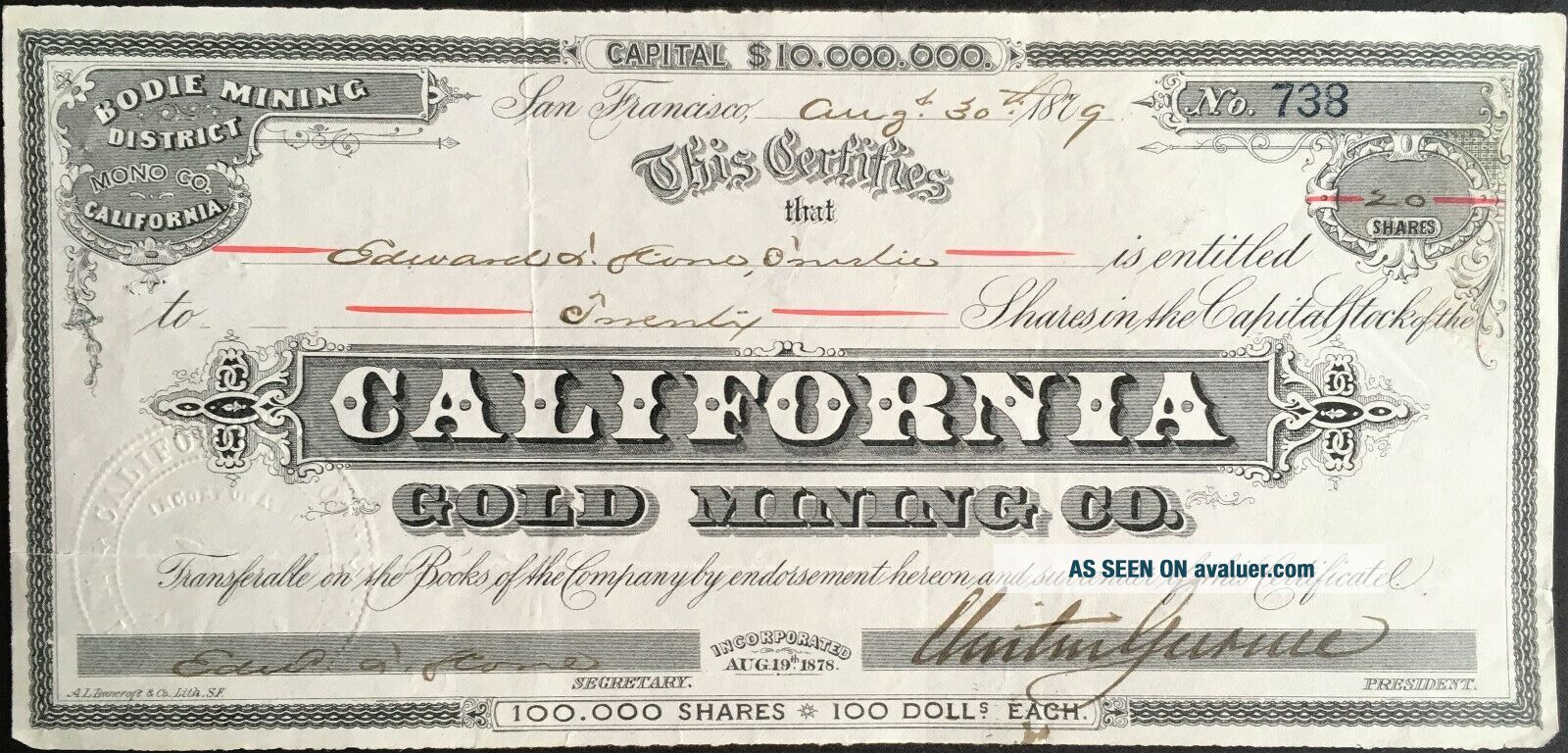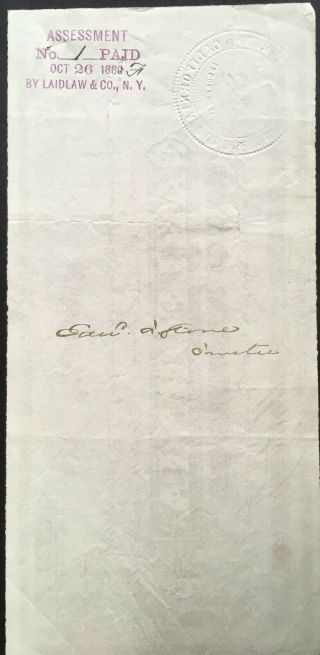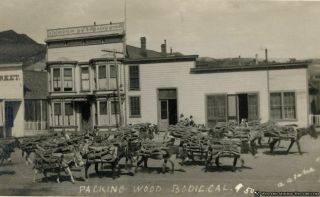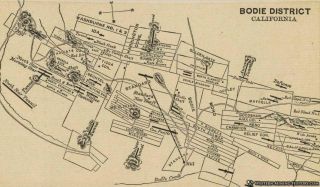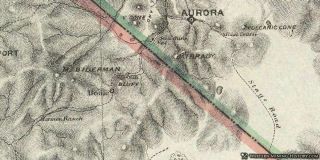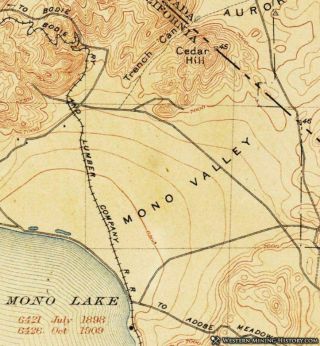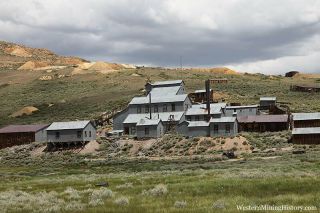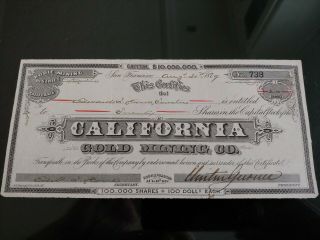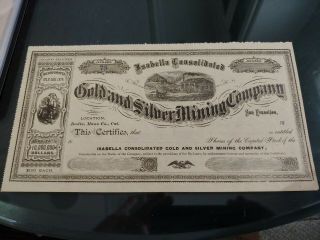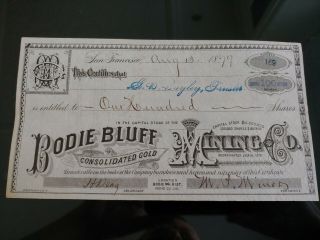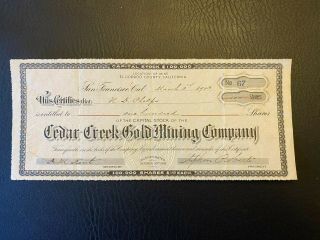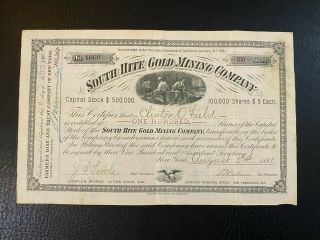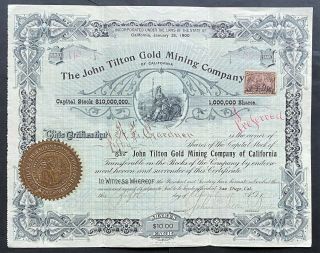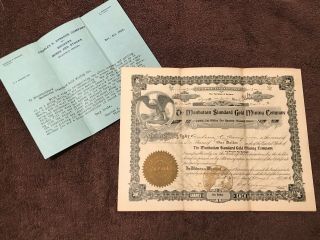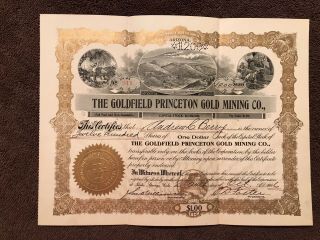CALIFORNIA GOLD MINING CO Stock 1879. Bodie Mining District Mono County, CA RARE
Item History & Price
| Reference Number: Avaluer:1206335 |
CaliforniaGold Mining Company. Issued on August 30, 1879 in San Francisco, California. Incorporated on August 19, 1878 (printed lower center).“Bodie Mining District, Mono County, California” printed upperleft corner. Embossed company seal lower left. Certificate No. 738was issued to Edward T. Slone, Trustee (and company secretary) for 20shares of capital stock ($100 per share). Company capital was$10, 000, 000 (very high dollar amount for 1879; in today's dollarswould be $250, 000,... 000). Original ink signatures of company presidentChristen Gunsell (?) and secretary Edward T. Slone. Certificate isabout 4” x 8.5”.
Condition:Very Fine, very light folds/creasing, notears, minor signs of wear/handling/discoloration, Uncancelled.Printer:A. L. Bancroft & Company, San Francisco.
Company History:TheCalifornia Gold Mining Company mines were located in the Bodie MiningDistrict, Mono County, California. Today, the old mining town of Bodie is a ghost town inthe Bodie Hills east of the Sierra Nevada mountain range, about 75 miles southeast of Lake Tahoe. Golddiscovered at Bodie coincided with the discovery of silver at thedistant Comstock Lode beneath Virginia City, Nevada. But while thesetwo towns boomed, interest in Bodie remained lackluster. By 1868 onlytwo companies had built stamp mills at Bodie, and both had failed. In1876, the Standard Company discovered a profitable deposit ofgold-bearing ore, which transformed Bodie from an isolated miningcamp comprising a few prospectors and company employees to a WildWest boom town. Rich discoveries in the adjacent Bodie Mine during1878 attracted even more hopeful people. By 1879, Bodie had apopulation of approximately 5, 000–7, 000 people.(the attached pictures show: photo of Bodie in the late 1800s; Bodie mining claims map ca. 1880; map showing the towns of Bodie and Aurora in 1873; USGS map showing the route of the Bodie Railway & Lumber Company; and the Standard Company stamp mill in Bodie)
WatermanS. “Bill” Bodey believed in Bodie. He was the pioneer miner whofirst found gold in the high peaks east of the future town. BillBodey was working a placer claim he established in July 1859. InNovember of that year he froze to death in a snowstorm. The stormblocked the trail to Bodey’s cabin and he may have gotten losttrying to find his way back. Hisname lives on in the name given to the new mining district in thelocale a few years later. The story goes that a sign painter innearby Aurora, Nevada, misspelled the name as “Bodie” and itstuck. Quartz deposits containing rich gold and silver were located atBodie beginning around September 1860. The Bodie Mining District wasestablished in June 1861 and a stamp mill was built. Although richplacers were noted, a lack of water was a problem, especially duringthe freezing winter months. At this time, Bodie was still a smallmining camp, with about 20 resident miners. Mono County wasestablished in April 1861 with the county seat at the young town ofAurora. There was a slight problem, though. Once the line betweenCalifornia and Nevada was surveyed, Aurora came out on the wrong sideof the line, in the new state of Nevada. Mono County did not believeenough in Bodie to make the mining camp the county seat. The town ofBridgeport, seven miles north of Bodie, was voted by the locals asthe new county seat in June 1864. Bridgeport began as a campgroundfor teamsters hauling lumber to the mines at Aurora, Bodie, and othercamps. Progress at the Bodie mines was reported in a letter fromAurora to a San Francisco newspaper in November 1863. The mines atBodie were taking out the most valuable ore the author had “everseen on this side of the mountains.” A survey of Bodie Bluff in1863 found that the summit was 750 feet from its base, where theminers’ cabins were located. The supervisor of one of the miningcompanies had built a “fine large shed” over the entrance to theOsceola mine shaft in the fall of 1863, to “protect the workmenfrom the cold and snow blasts that blow almost incessantly during thewinter season.” The shed also served as a locale for sorting theore. Rumors were swirling in the summer of 1864 that New Yorkers witha half million dollars to invest in mining were on their way toBodie. The New Yorkers ended up establishing the Empire MiningCompany. For another decade, mining was sporadic and small in scalein Bodie. Reported mismanagement closed the Empire Mill and MiningCompany, and it was sold in bankruptcy in 1868. The new ownersplanned to run the mill more regularly. The first governor of Nevada, Henry G. Blasdel, bought the Home Stake Mine and Mill at Bodie in 1868. Nomajor strikes in Bodie caused much excitement, though. That began tochange by the mid-1870s, with more promising discoveries. Silas Smithbelieved in Bodie. He opened a store in Bodie in May 1877, moving thebuilding from his business in Aurora, Nevada. The U.S. Postal Serviceopened a post office in Bodie by April 1877. In December of thatyear, the first non-stop stagecoach trip from Carson, Nevada reachedBodie. After February 1878, three stages a day linked Aurora toBodie. A rich strike by the Bodie Mining Company in June 1878convinced even more folks that Bodie really was the next big thing.Miners and would-be miners flocked to Bodie and it seemed likeeveryone finally believed in the little town. With the gold rush toBodie, dozens of businesses followed, hoping to part some of theirearnings from the miners on payday. Saloons, dance halls, opium dens, and brothels soon lined the streets. Shootings became a commonoccurrence in the town. Bodie had its share of mischief during theboom years. One character caught the country’s attention, known asthe “Bad Man of Bodie.” One former resident - Oscar Morgan, sonof the Mono County sheriff - claimed in 1939 that the moniker appliedto more than one person. Another former local thought the story wasfictional. One fantastic tale of the Bad Man of Bodie has him in agunfight in the street at two feet apart from his opponent. Afterbeing shot in one arm and falling, the opponent is said to havemanaged to use his knees to hold his gun while firing the fatal shotwith his good arm, downing the Bad Man once and for all. A locallegend tells of a little girl who was moving from San Francisco withher family to Bodie. She reportedly wrote in her diary “Goodbye, God, I’m going to Bodie.” This child definitely did not believein Bodie. Silas Smith and four other local men contributed funds tobuild a racetrack on the flat south of town along Bodie Creek.Gambling on the horse races became a popular pastime for the localsfor decades to come. Bodie was a large camp situated at highelevation, and in a barren landscape. Constant wood shortages forboth use in the mines and by the citizens plagued the town. Theseshortages became an insurmountable problem by the early 1880s asmining activity peaked. During Bodies Boom years, there was anestimated 60 miles of mine tunnels that needed timbering. TheStandard Mill alone used 20 cords of fuel wood a day, and all themines in the area used over 300 cords per day during times of peakproduction. Add to that the thousands of residents needing wood forcooking, heating, and construction, and Bodie was in need of entireforests worth of wood but no way to get it. Bodie's insatiable demandfor fuel wood and lumber led to the creation of the Bodie Woodand Lumber Company’s sawmill in Mono Mills. Located around 32 milessouth of Bodie near Mono Lake, Mono Mills was linked to Bodie by anarrow gauge railroad by November 1881. Spur lines to connect themill to timber regions were finished in 1882. Mono Mills was anisolated community that existed almost entirely to serve Bodies needfor wood. The railroad only connected Bodie to Mono Mills, there wereno outside connections to either community. Mining activity in Bodiehad waned by the early decades of the twentieth century and demandfor lumber products declined. With the decreased need for lumber, therail line to Mono Mills was abandoned in 1918. The depot remainsstanding in Bodie but nothing is left in Mono Mills. The Bodie boomstarted to slow during the latter half of the 1880s and thepopulation dwindled from its peak of nearly 10, 000. The twonewspapers printed in town were consolidated to one in 1880, to bepublished weekly. A twenty-stamp mill in town burned down in 1898, dealing a blow to the Standard Consolidated Mining Company. While themill was totally destroyed, the company’s office and cyanide plantwere saved; insurance only partly covered the damage.
PAYMENTAND SHIPPING Please read certificate description details shown above before bidding. Please contact me with any questions before bidding. Payment by PayPal only. Shipping within the U.S. is by USPS First Class Mail ($4.00 for packages weighing 13 ounces or less) – shipping for packages weighing over 13 ounces will be shown on your invoice. If another shipping method is requested, a revised invoice will be sent. International buyers need to wait for my invoice before paying. Combined shipping cost will be offered for multiple items won – please wait for invoice before paying, or if specific shipping method or insurance is requested. Multiple items will be shipped together in one package. All packages will be shipped with certificates placed in plastic sleeves with cardboard backing and marked “Do Not Bend”. I do not profit on shipping costs charged. Items typically shipped within two days of payment.RETURNSAND GUARANTEE: Buyer satisfaction and authenticity of certificate is guaranteed – returns are accepted with 14 days of purchase (buyer pays return shipping cost unless item received is not as described in this listing). All certificates are originals – no reproductions.
Condition:Very Fine, very light folds/creasing, notears, minor signs of wear/handling/discoloration, Uncancelled.Printer:A. L. Bancroft & Company, San Francisco.
Company History:TheCalifornia Gold Mining Company mines were located in the Bodie MiningDistrict, Mono County, California. Today, the old mining town of Bodie is a ghost town inthe Bodie Hills east of the Sierra Nevada mountain range, about 75 miles southeast of Lake Tahoe. Golddiscovered at Bodie coincided with the discovery of silver at thedistant Comstock Lode beneath Virginia City, Nevada. But while thesetwo towns boomed, interest in Bodie remained lackluster. By 1868 onlytwo companies had built stamp mills at Bodie, and both had failed. In1876, the Standard Company discovered a profitable deposit ofgold-bearing ore, which transformed Bodie from an isolated miningcamp comprising a few prospectors and company employees to a WildWest boom town. Rich discoveries in the adjacent Bodie Mine during1878 attracted even more hopeful people. By 1879, Bodie had apopulation of approximately 5, 000–7, 000 people.(the attached pictures show: photo of Bodie in the late 1800s; Bodie mining claims map ca. 1880; map showing the towns of Bodie and Aurora in 1873; USGS map showing the route of the Bodie Railway & Lumber Company; and the Standard Company stamp mill in Bodie)
WatermanS. “Bill” Bodey believed in Bodie. He was the pioneer miner whofirst found gold in the high peaks east of the future town. BillBodey was working a placer claim he established in July 1859. InNovember of that year he froze to death in a snowstorm. The stormblocked the trail to Bodey’s cabin and he may have gotten losttrying to find his way back. Hisname lives on in the name given to the new mining district in thelocale a few years later. The story goes that a sign painter innearby Aurora, Nevada, misspelled the name as “Bodie” and itstuck. Quartz deposits containing rich gold and silver were located atBodie beginning around September 1860. The Bodie Mining District wasestablished in June 1861 and a stamp mill was built. Although richplacers were noted, a lack of water was a problem, especially duringthe freezing winter months. At this time, Bodie was still a smallmining camp, with about 20 resident miners. Mono County wasestablished in April 1861 with the county seat at the young town ofAurora. There was a slight problem, though. Once the line betweenCalifornia and Nevada was surveyed, Aurora came out on the wrong sideof the line, in the new state of Nevada. Mono County did not believeenough in Bodie to make the mining camp the county seat. The town ofBridgeport, seven miles north of Bodie, was voted by the locals asthe new county seat in June 1864. Bridgeport began as a campgroundfor teamsters hauling lumber to the mines at Aurora, Bodie, and othercamps. Progress at the Bodie mines was reported in a letter fromAurora to a San Francisco newspaper in November 1863. The mines atBodie were taking out the most valuable ore the author had “everseen on this side of the mountains.” A survey of Bodie Bluff in1863 found that the summit was 750 feet from its base, where theminers’ cabins were located. The supervisor of one of the miningcompanies had built a “fine large shed” over the entrance to theOsceola mine shaft in the fall of 1863, to “protect the workmenfrom the cold and snow blasts that blow almost incessantly during thewinter season.” The shed also served as a locale for sorting theore. Rumors were swirling in the summer of 1864 that New Yorkers witha half million dollars to invest in mining were on their way toBodie. The New Yorkers ended up establishing the Empire MiningCompany. For another decade, mining was sporadic and small in scalein Bodie. Reported mismanagement closed the Empire Mill and MiningCompany, and it was sold in bankruptcy in 1868. The new ownersplanned to run the mill more regularly. The first governor of Nevada, Henry G. Blasdel, bought the Home Stake Mine and Mill at Bodie in 1868. Nomajor strikes in Bodie caused much excitement, though. That began tochange by the mid-1870s, with more promising discoveries. Silas Smithbelieved in Bodie. He opened a store in Bodie in May 1877, moving thebuilding from his business in Aurora, Nevada. The U.S. Postal Serviceopened a post office in Bodie by April 1877. In December of thatyear, the first non-stop stagecoach trip from Carson, Nevada reachedBodie. After February 1878, three stages a day linked Aurora toBodie. A rich strike by the Bodie Mining Company in June 1878convinced even more folks that Bodie really was the next big thing.Miners and would-be miners flocked to Bodie and it seemed likeeveryone finally believed in the little town. With the gold rush toBodie, dozens of businesses followed, hoping to part some of theirearnings from the miners on payday. Saloons, dance halls, opium dens, and brothels soon lined the streets. Shootings became a commonoccurrence in the town. Bodie had its share of mischief during theboom years. One character caught the country’s attention, known asthe “Bad Man of Bodie.” One former resident - Oscar Morgan, sonof the Mono County sheriff - claimed in 1939 that the moniker appliedto more than one person. Another former local thought the story wasfictional. One fantastic tale of the Bad Man of Bodie has him in agunfight in the street at two feet apart from his opponent. Afterbeing shot in one arm and falling, the opponent is said to havemanaged to use his knees to hold his gun while firing the fatal shotwith his good arm, downing the Bad Man once and for all. A locallegend tells of a little girl who was moving from San Francisco withher family to Bodie. She reportedly wrote in her diary “Goodbye, God, I’m going to Bodie.” This child definitely did not believein Bodie. Silas Smith and four other local men contributed funds tobuild a racetrack on the flat south of town along Bodie Creek.Gambling on the horse races became a popular pastime for the localsfor decades to come. Bodie was a large camp situated at highelevation, and in a barren landscape. Constant wood shortages forboth use in the mines and by the citizens plagued the town. Theseshortages became an insurmountable problem by the early 1880s asmining activity peaked. During Bodies Boom years, there was anestimated 60 miles of mine tunnels that needed timbering. TheStandard Mill alone used 20 cords of fuel wood a day, and all themines in the area used over 300 cords per day during times of peakproduction. Add to that the thousands of residents needing wood forcooking, heating, and construction, and Bodie was in need of entireforests worth of wood but no way to get it. Bodie's insatiable demandfor fuel wood and lumber led to the creation of the Bodie Woodand Lumber Company’s sawmill in Mono Mills. Located around 32 milessouth of Bodie near Mono Lake, Mono Mills was linked to Bodie by anarrow gauge railroad by November 1881. Spur lines to connect themill to timber regions were finished in 1882. Mono Mills was anisolated community that existed almost entirely to serve Bodies needfor wood. The railroad only connected Bodie to Mono Mills, there wereno outside connections to either community. Mining activity in Bodiehad waned by the early decades of the twentieth century and demandfor lumber products declined. With the decreased need for lumber, therail line to Mono Mills was abandoned in 1918. The depot remainsstanding in Bodie but nothing is left in Mono Mills. The Bodie boomstarted to slow during the latter half of the 1880s and thepopulation dwindled from its peak of nearly 10, 000. The twonewspapers printed in town were consolidated to one in 1880, to bepublished weekly. A twenty-stamp mill in town burned down in 1898, dealing a blow to the Standard Consolidated Mining Company. While themill was totally destroyed, the company’s office and cyanide plantwere saved; insurance only partly covered the damage.
PAYMENTAND SHIPPING Please read certificate description details shown above before bidding. Please contact me with any questions before bidding. Payment by PayPal only. Shipping within the U.S. is by USPS First Class Mail ($4.00 for packages weighing 13 ounces or less) – shipping for packages weighing over 13 ounces will be shown on your invoice. If another shipping method is requested, a revised invoice will be sent. International buyers need to wait for my invoice before paying. Combined shipping cost will be offered for multiple items won – please wait for invoice before paying, or if specific shipping method or insurance is requested. Multiple items will be shipped together in one package. All packages will be shipped with certificates placed in plastic sleeves with cardboard backing and marked “Do Not Bend”. I do not profit on shipping costs charged. Items typically shipped within two days of payment.RETURNSAND GUARANTEE: Buyer satisfaction and authenticity of certificate is guaranteed – returns are accepted with 14 days of purchase (buyer pays return shipping cost unless item received is not as described in this listing). All certificates are originals – no reproductions.



